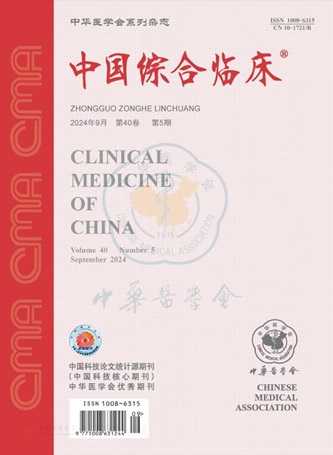Clinical characteristics of early Parkinson′s disease patients with emotional apathy and its relationship with other non-motor symptoms
引用次数: 1
Abstract
Objective To observe the characteristics of apathy in early Parkinson′s disease patients, analyze its relationship with other non-motor symptoms, and explore its impact on the quality of life. Methods Clinical data of 75 patients with Parkinson′s disease admitted to xingtai people′s hospital from August 2014 to August 2017 were selected.Unified Parkinson′s disease rating scale- III(UPDRS-III ), Modified apathy rating scale(MAES ), Montgomy-asberg Depression rating scale(MADRS ) and Simple mental state test(MMSE) were used to evaluate patients′ motor symptoms, indifference, depression and cognitive function.The relationship between apathy and other non-motor symptoms was analyzed by Parkinson′s disease non-motor symptom evaluation scale.Parkinson′s disease questionnaire-39(PDQ-39) was used to evaluate the quality of life.The patients were divided into the affective indifference group and the non-affective indifference group according to whether the patients were accompanied by affective indifference. Results 21.3%(16/75) of the patients were diagnosed with apathy.Emotional indifference group UPDRS score -Ⅲ (23.98±9.46), not apathy group(14.74±6.27). There was significant difference between the two groups (P<0.001). MMSE score of the indifferent group was (21.26±3.21), and that of the non-indifferent group was (26.57±3.42). There was significant difference between the two groups (P=0.038). PDQ-39 score of the emotionally indifferent group was (65.20±25.78), which was significantly higher than that of the non-emotionally indifferent group (34.86±25.42). There was significant difference between the two groups (P<0.001). In the comparison of Parkinson′s disease non-motor symptom evaluation scale, the fatigue symptom score of the emotionally indifferent group was (6.1±0.2) significantly higher than that of the non-indifferent group (2.3±0.7), and the difference was statistically significant (P=0.006). The score of lack of interest was (4.8±1.5) in the indifferent group and (1.3±0.8) in the non-indifferent group.The difference between the two groups was statistically significant (P=0.017). Conclusion Apathy has a high incidence in early Parkinson′s disease patients, often combined with fatigue and lack of interest symptoms.It has a serious impact on the quality of daily life in the future. Key words: Parkinson′s disease; Apathy; Unified Parkinson′s disease rating scale- III; Modified apathy evaluation scale; Montgomery-asberg depression rating scale; Mini-mental state examination; Non-motor symptom; Quality of life早期帕金森病患者情绪冷漠的临床特征及其与其他非运动症状的关系
目的观察早期帕金森病患者冷漠的特点,分析其与其他非运动症状的关系,探讨其对生活质量的影响。方法选取邢台市人民医院2014年8月至2017年8月收治的75例帕金森病患者的临床资料。采用统一帕金森病评定量表-Ⅲ(UPDRS-III)、改良冷漠评定量表(MAES)、Montgomy-asberg抑郁评定量表和简易精神状态测试(MMSE)评定患者的运动症状、冷漠、抑郁和认知功能。采用帕金森病非运动症状评定量表分析冷漠与其他非运动症状的关系。帕金森病问卷-39(PDQ-39)用于评估患者的生活质量。根据患者是否伴有情感冷漠,将患者分为情感冷漠组和非情感冷漠组。结果21.3%(16/75)的患者被诊断为冷漠。情感冷漠组UPDRS评分-Ⅲ(23.98±9.46)而非冷漠组(14.74±6.27),两组比较有显著性差异(P<0.001),两组间比较有显著性差异(P=0.038),情感冷漠组PDQ-39分为(65.20±25.78),两组比较有显著性差异(P<0.001)。在帕金森病非运动症状评定量表的比较中,情绪冷漠组的疲劳症状评分(6.1±0.2)显著高于非情绪冷漠组(2.3±0.7),差异有统计学意义(P=0.006)。无兴趣组为(4.8±1.5)分,无兴趣组(1.3±0.8)分。两组比较有统计学意义(P=0.017)。它对未来的日常生活质量有着严重的影响。关键词:帕金森病;冷漠;帕金森病统一评定量表-Ⅲ;改良冷漠评价量表;Montgomery-asberg抑郁症评定量表;小型精神状态检查;非运动症状;生活质量
本文章由计算机程序翻译,如有差异,请以英文原文为准。
求助全文
约1分钟内获得全文
求助全文
来源期刊
CiteScore
0.10
自引率
0.00%
发文量
16855
期刊介绍:
Clinical Medicine of China is an academic journal organized by the Chinese Medical Association (CMA), which mainly publishes original research papers, reviews and commentaries in the field.
Clinical Medicine of China is a source journal of Peking University (2000 and 2004 editions), a core journal of Chinese science and technology, an academic journal of RCCSE China Core (Extended Edition), and has been published in Chemical Abstracts of the United States (CA), Abstracts Journal of Russia (AJ), Chinese Core Journals (Selection) Database, Chinese Science and Technology Materials Directory, Wanfang Database, China Academic Journal Database, JST Japan Science and Technology Agency Database (Japanese) (2018) and other databases.

 求助内容:
求助内容: 应助结果提醒方式:
应助结果提醒方式:


